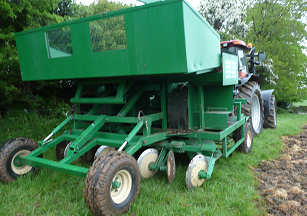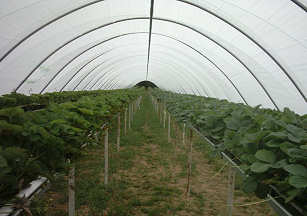| Newsletter Winter 2009 | page 2 of 4 | |
 |
|
 |
Planting Elephant Grass
 Another new venture that kept me
busy this spring was planting a 10 acre field of elephant grass. Now I’m
not saying that I personally planted the crop myself; the land was
tilled by local contractor Philip Kiely, and the planting done by
rhizome suppliers Tippgen. However, it somehow still kept me busy.
Elephant grass is a perennial grass which grows up from its roots each
year. It is an amazing plant which in Ireland can grow to ten feet tall
in a single year, but yet requires no fertilizer and is tolerant of
drought. Its attraction in a world of diminishing fuel supply is as a
biomass crop. It can be harvested year after year, and the shoots used
in power stations in place of peat, or in homes and industry in place of
coal, oil and gas. Because it is practically carbon neutral, it not only
offers the hope of a new more-reasonably priced alternative to fossil
fuels, but its cost need not rise in line with oil prices, especially if
these escalate rapidly as happened almost two years ago. In addition, it
does not contribute to global warming, and indeed, research is currently
under way to investigate if the carbon trapped in the tap roots might
even act as a carbon sink, taking harmful carbon dioxide out of the
atmosphere. I planted this crop because I feel that as a user of fuels
in my daily life (whether driving to town or heating my home), I ought
to use the opportunity presented by being a farmer to reduce carbon
outputs and become involved in making a positive contribution towards
lowering Ireland’s massive energy bill, most of which is spent on
importing fossil fuels (the last time I checked, Ireland spent 7 billion
euros a year on imported fuels. If we could keep even half of that in
Ireland it would solve so many of our financial woes). From a growers
perspective, the ten acres will produce about 100 tons of dry matter
each year. While that is far more than I would require for personal use,
the crop will be purchased by Tippgen, who in turn will use it to supply
to their local energy customers. It just seems like such a sensible way
to operate. Local energy crops for local energy use.
Another new venture that kept me
busy this spring was planting a 10 acre field of elephant grass. Now I’m
not saying that I personally planted the crop myself; the land was
tilled by local contractor Philip Kiely, and the planting done by
rhizome suppliers Tippgen. However, it somehow still kept me busy.
Elephant grass is a perennial grass which grows up from its roots each
year. It is an amazing plant which in Ireland can grow to ten feet tall
in a single year, but yet requires no fertilizer and is tolerant of
drought. Its attraction in a world of diminishing fuel supply is as a
biomass crop. It can be harvested year after year, and the shoots used
in power stations in place of peat, or in homes and industry in place of
coal, oil and gas. Because it is practically carbon neutral, it not only
offers the hope of a new more-reasonably priced alternative to fossil
fuels, but its cost need not rise in line with oil prices, especially if
these escalate rapidly as happened almost two years ago. In addition, it
does not contribute to global warming, and indeed, research is currently
under way to investigate if the carbon trapped in the tap roots might
even act as a carbon sink, taking harmful carbon dioxide out of the
atmosphere. I planted this crop because I feel that as a user of fuels
in my daily life (whether driving to town or heating my home), I ought
to use the opportunity presented by being a farmer to reduce carbon
outputs and become involved in making a positive contribution towards
lowering Ireland’s massive energy bill, most of which is spent on
importing fossil fuels (the last time I checked, Ireland spent 7 billion
euros a year on imported fuels. If we could keep even half of that in
Ireland it would solve so many of our financial woes). From a growers
perspective, the ten acres will produce about 100 tons of dry matter
each year. While that is far more than I would require for personal use,
the crop will be purchased by Tippgen, who in turn will use it to supply
to their local energy customers. It just seems like such a sensible way
to operate. Local energy crops for local energy use.
Spanish tunnels
 During what we called our “summer” we were
busy with the Spanish tunnels. If you have a look at our website, you
will see an aerial photograph showing them. They are low-tech tunnels
which are large enough to walk into, and in these we grow cherries,
raspberries and strawberries, and from next year hopefully some plums
too. While the majority of our strawberries, raspberries and plums are
grown outdoors, this is not really possible for cherries, as the weather
tends to be too cool at flowering, and too wet during the summer. It is
really convenient to have some tunnels for the soft fruit also, as if
the forecast is for wet weather one day and dry another, we can organize
to harvest the indoor fruit on the wet day, and the outdoor fruit on the
dry day. It really suits everyone like this, because on a nice summer
day we all like to be out, but if it’s wet, the protection of the
covers is much appreciated. The tunnel design originated in Spain, which
is how they got their name. They are not suited to stormy weather
though, so in the autumn we take off the plastic covers, and in the
spring we put them back on again. That is a tricky job, as it is vital
that there is not the slightest breeze, as the huge section of plastic
first needs to be put in place, and then tied down. Even a little wind
when doing this job could lift the plastic (and all who hold onto it)
high into the sky. Thus far though, we have always managed to pick a
calm morning for the job; a skill I hope that we can repeat again next
year.
During what we called our “summer” we were
busy with the Spanish tunnels. If you have a look at our website, you
will see an aerial photograph showing them. They are low-tech tunnels
which are large enough to walk into, and in these we grow cherries,
raspberries and strawberries, and from next year hopefully some plums
too. While the majority of our strawberries, raspberries and plums are
grown outdoors, this is not really possible for cherries, as the weather
tends to be too cool at flowering, and too wet during the summer. It is
really convenient to have some tunnels for the soft fruit also, as if
the forecast is for wet weather one day and dry another, we can organize
to harvest the indoor fruit on the wet day, and the outdoor fruit on the
dry day. It really suits everyone like this, because on a nice summer
day we all like to be out, but if it’s wet, the protection of the
covers is much appreciated. The tunnel design originated in Spain, which
is how they got their name. They are not suited to stormy weather
though, so in the autumn we take off the plastic covers, and in the
spring we put them back on again. That is a tricky job, as it is vital
that there is not the slightest breeze, as the huge section of plastic
first needs to be put in place, and then tied down. Even a little wind
when doing this job could lift the plastic (and all who hold onto it)
high into the sky. Thus far though, we have always managed to pick a
calm morning for the job; a skill I hope that we can repeat again next
year.
- Page 1: A new plum orchard
- Page 3: Irrigation, A New Award
- Page 4: A Book Launch, Miracle of Apple Juice
- Newsletter main page
Home | Caravan & Camping |
Apple Juice | Fruits | Farm Shop |
Online Shop | Newsletter | Contact Us | About Us | Environment | Awards | Video
Clips | Links |
Booking | Map
| Guestbook
| Weather
